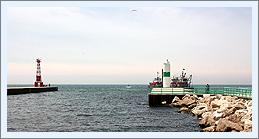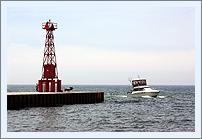|
Historical
Information

As was the case at many locations along the eastern shore of Lake
Michigan, Pentwater lake’s only natural connection to Lake Michigan was
through a shallow and swampy creek, barring access to the lake to all
but the lightest canoes and row boats.
The value of opening up a channel between the lakes was recognized
early, as evidenced by an 1838 report submitted to the Fifth Auditor of
the Treasury by Thomas Homans, superintendent of lighthouses for the
northwestern lakes. In his report, Homans suggested that "the Rivers au
Betaux, Manistee, Pere Marquette, White and Pentwater are capable of
being made excellent and safe harbors, accessible to any vessels
navigating the lakes. Two parallel piers to each of moderate length and
of trivial cost compared to the utility would soon make an abundance of
fine harbors on this shore where they are so much needed." While the
federal government was thus clearly aware of the value of opening up
such a channel at Pentwater, it would be almost 20 years before work
would begin, and it would then be undertaken as a private enterprise
without the benefit of any federal support.
After purchasing tracts of pine forest around the shores of the lake
for $1.00 an acre in 1855, lumber baron Charles Mears established a mill
at the northwest end of the lake. A thriving community grew quickly to
support the mill, and was incorporated under the name of Middlesex in
1856. Without a navigable channel through which to gain direct access to
the lake, the mill remained virtually landlocked, and thus lumber had to
be dragged out to the lakeshore where it was lightered onto awaiting
vessels anchored offshore for transport to Mears’ yards in Chicago.
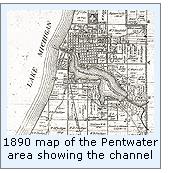 Between 1856 and 1858, Mears work crews dammed the swampy outlet in
order to raise the water level within the lake, and excavated a shallow
channel through the narrow sand dunes to the south of the mill. Lined
with timber cribbing and revetments, and protected with a pair of short
parallel piers, the channel was opened up to a width of seventy feet.
However, the goal of creating a channel deep and wide enough to allow
vessels direct access to the mill had yet to be attained. While fishing
boats and small coastal vessels were now able to make the passage
through the channel into Pentwater Lake, there was insufficient depth
for the larger lumber hookers. Thus, lumber was loaded onto a narrow
gage railway and transported out to the end of the north pier, where the
water was deep enough for larger vessels to tie up. Between 1856 and 1858, Mears work crews dammed the swampy outlet in
order to raise the water level within the lake, and excavated a shallow
channel through the narrow sand dunes to the south of the mill. Lined
with timber cribbing and revetments, and protected with a pair of short
parallel piers, the channel was opened up to a width of seventy feet.
However, the goal of creating a channel deep and wide enough to allow
vessels direct access to the mill had yet to be attained. While fishing
boats and small coastal vessels were now able to make the passage
through the channel into Pentwater Lake, there was insufficient depth
for the larger lumber hookers. Thus, lumber was loaded onto a narrow
gage railway and transported out to the end of the north pier, where the
water was deep enough for larger vessels to tie up.
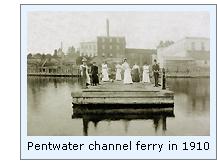 While the excavation of the channel was a boon to the growing
Pentwater fishing fleet, it proved somewhat of a nuisance to travel
between the settlements on the north and west shores of the lake. To
this end, a ferry was placed into operation across the channel in 1858.
Consisting of a wooden scow, motive power was provided by a winch
connected to a cable that ran across the bottom between both banks. For
the privilege of avoiding the long trip around the two-mile length of
the lake, passengers paid 5 cents each, 10 cents for a man with a horse,
25 cents for a team and wagon, and 2 cents each for livestock. After
almost ten years of continued improvements, Mears work finally paid off
in 1865, when the steamer DAYLITE became the first large vessel to make
her way between the piers and through the channel into Pentwater Lake.
With the channel thus opened to general maritime commerce, a number of
independent lumber-related interests moved into the area, perhaps the
largest of which was Eldred's Shingle Mill. Located at the south end of
Pentwater Lake, this mill grew to be the largest of its type in the
state of Michigan, and according to some reports, the largest in the
country. While the excavation of the channel was a boon to the growing
Pentwater fishing fleet, it proved somewhat of a nuisance to travel
between the settlements on the north and west shores of the lake. To
this end, a ferry was placed into operation across the channel in 1858.
Consisting of a wooden scow, motive power was provided by a winch
connected to a cable that ran across the bottom between both banks. For
the privilege of avoiding the long trip around the two-mile length of
the lake, passengers paid 5 cents each, 10 cents for a man with a horse,
25 cents for a team and wagon, and 2 cents each for livestock. After
almost ten years of continued improvements, Mears work finally paid off
in 1865, when the steamer DAYLITE became the first large vessel to make
her way between the piers and through the channel into Pentwater Lake.
With the channel thus opened to general maritime commerce, a number of
independent lumber-related interests moved into the area, perhaps the
largest of which was Eldred's Shingle Mill. Located at the south end of
Pentwater Lake, this mill grew to be the largest of its type in the
state of Michigan, and according to some reports, the largest in the
country.
With the economic viability of the channel thus proven, and facing
the costs of endless pier repair and channel dredging, Mears began
lobbying for federal government to assume responsibility for the woks.
Taking up Mears cause in 1867, Michigan Senators Thomas White Ferry and
Zachariah Chandler successfully presented bills before Congress calling
for the appropriation of funding for harbor improvements at Pentwater,
with the initial $55,000 appropriated for the project on March 6, 1867.
Thus, late in 1867, the US Army Corps of Engineers arrived in Pentwater
to commence a 20-year program to widen the channel to 150 feet, extend
the piers, and to open up the channel to a minimum planned navigable
depth of 16 feet.
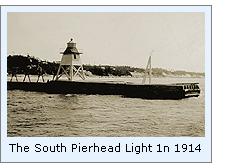 With construction well underway, the Lighthouse Board determined that
the establishment of a light on one of the piers would serve to guide
vessels into the channel. To this end, a lighthouse crew was dispatched
to Pentwater in the spring of 1873 to begin construction of a beacon at
the end of the south pier. The structure took the form of a white
painted simple timber-framed pyramid structure standing 12 feet in plan.
With the upper section enclosed serve as both a service room and as
shelter for the keeper during inclement weather, the structure tapered
to 8 feet in plan beneath the gallery, which was capped by an octagonal
cast iron lantern. While the lantern’s window astragals were of typical
construction, the lantern walls were formed by extensions of the wooden
walls below, as opposed to typical prefabricated cast iron sections. A
spherical cast iron vent ball capped the tapered octagonal roof, and was
in turn surmounted by a platinum-tipped lightning rod standing 33 feet
above the pier deck. With construction well underway, the Lighthouse Board determined that
the establishment of a light on one of the piers would serve to guide
vessels into the channel. To this end, a lighthouse crew was dispatched
to Pentwater in the spring of 1873 to begin construction of a beacon at
the end of the south pier. The structure took the form of a white
painted simple timber-framed pyramid structure standing 12 feet in plan.
With the upper section enclosed serve as both a service room and as
shelter for the keeper during inclement weather, the structure tapered
to 8 feet in plan beneath the gallery, which was capped by an octagonal
cast iron lantern. While the lantern’s window astragals were of typical
construction, the lantern walls were formed by extensions of the wooden
walls below, as opposed to typical prefabricated cast iron sections. A
spherical cast iron vent ball capped the tapered octagonal roof, and was
in turn surmounted by a platinum-tipped lightning rod standing 33 feet
above the pier deck.
A timber elevated walkway was constructed leading from the shore to a
door in the service room to provide the keeper with safer access to the
light above the waves which frequently crashed over the surface of the
pier during early winter Lake Michigan storms. With the arrival of the
district Lampist from Detroit, a fixed red Sixth Order Fresnel lens was
installed on a cast iron pedestal at a focal plane of 25 feet, and the
light was exhibited for the first time on the evening of June 20, 1873.
Outfitted with a single-wick Sixth Order lamp exhibiting 45 candlepower,
the new Pentwater light was visible at a distance of 8 ˝ miles.
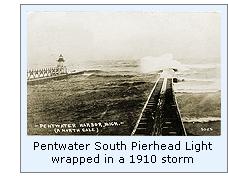 Funding for the erection of the beacon was taken from a general
appropriation for establishing pierhead beacons throughout the district,
and was insufficient for erecting a dwelling for the station. As a
result, the new station’s keeper would be responsible for making his own
living arrangements from his standard lighthouse service salary. John
Davenport, former First Assistant keeper at Skilligalee light was
offered the position of Keeper at Pentwater, but declined the promotion,
perhaps as a result of the lack of a dwelling. Thus, the position
remained unfilled at the time of the light’s initial exhibition, and
thus a member of the construction crew was likely held over to maintain
the light until a keeper was selected. The position was eventually
offered to local resident Francis McGuire, and he appears for the first
time on lighthouse payroll records at the station on October 22, 1873.
Evidently, Keeper McGuire found more lucrative employment in the area,
since re resigned from lighthouse service on March 3, 1877, and his wife
Annie was immediately appointed as Acting Keeper, and after six months
proving her capabilities, she was promoted to full Keeper status on
September 20. Funding for the erection of the beacon was taken from a general
appropriation for establishing pierhead beacons throughout the district,
and was insufficient for erecting a dwelling for the station. As a
result, the new station’s keeper would be responsible for making his own
living arrangements from his standard lighthouse service salary. John
Davenport, former First Assistant keeper at Skilligalee light was
offered the position of Keeper at Pentwater, but declined the promotion,
perhaps as a result of the lack of a dwelling. Thus, the position
remained unfilled at the time of the light’s initial exhibition, and
thus a member of the construction crew was likely held over to maintain
the light until a keeper was selected. The position was eventually
offered to local resident Francis McGuire, and he appears for the first
time on lighthouse payroll records at the station on October 22, 1873.
Evidently, Keeper McGuire found more lucrative employment in the area,
since re resigned from lighthouse service on March 3, 1877, and his wife
Annie was immediately appointed as Acting Keeper, and after six months
proving her capabilities, she was promoted to full Keeper status on
September 20.
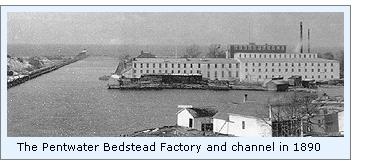 By the 1880’s virtually all of the white pine had been removed from
the area, and lumbering interests began moving-on to other locations
around the lakes where pine was still plentiful. In May 1882, the
Pentwater Furniture Company was formed on land purchased from Mears, and
began operations making furniture from the hardwoods which had been left
standing after the pine had been clear cut. The new factory consisted of
a large 100 foot by 50 foot four-story building with a separate brick
boiler and engine room. After five years operation, the factory began
experiencing financial difficulties, and on January 1, 1887 it was taken
over by the Sands and Maxwell Lumber Company under the name of the
Pentwater Bedstead Company. 1887 was also the year in which Annie
McGuire was removed from her position as keeper of the Pentwater Light,
to be replaced by Barney Evers who was appointed to the position on
March 11. Evidently, the Bedstead company flourished under its new
management, as a detached two-story 48-foot by 164-foot brick addition
was erected in 1888 and connected to the original building by a tramway
bridging the second floors of the two structures. The following year on
October 21, the boiler exploded killing three men. The boiler house was
rebuilt and the factory quickly resumed operations. By the 1880’s virtually all of the white pine had been removed from
the area, and lumbering interests began moving-on to other locations
around the lakes where pine was still plentiful. In May 1882, the
Pentwater Furniture Company was formed on land purchased from Mears, and
began operations making furniture from the hardwoods which had been left
standing after the pine had been clear cut. The new factory consisted of
a large 100 foot by 50 foot four-story building with a separate brick
boiler and engine room. After five years operation, the factory began
experiencing financial difficulties, and on January 1, 1887 it was taken
over by the Sands and Maxwell Lumber Company under the name of the
Pentwater Bedstead Company. 1887 was also the year in which Annie
McGuire was removed from her position as keeper of the Pentwater Light,
to be replaced by Barney Evers who was appointed to the position on
March 11. Evidently, the Bedstead company flourished under its new
management, as a detached two-story 48-foot by 164-foot brick addition
was erected in 1888 and connected to the original building by a tramway
bridging the second floors of the two structures. The following year on
October 21, the boiler exploded killing three men. The boiler house was
rebuilt and the factory quickly resumed operations.
To make finding the entry between he piers easier, a fixed red lens
lantern was suspended from a 17-foot tall post at the outer end of the
south pier to serve as a Front Range to the beacon in 1890. In 1899,
after braving the elements for 26 years, the pierhead beacon and the
section of pier on which it was standing were both found to be
significantly deteriorating, and it was moved to the inner end of the
outer crib, which was in better condition. Simultaneous with the move,
new lower timbers were spliced onto the four main support posts and the
sills of the service room were replaced on three sides. The following
year, the 500 foot-long elevated walk was replaced and the entire
surface of the pier was planked-over to better serve as a landing, and
to provide a safe walking surface for the many people who walked the
length of the pier for fishing and general recreation. That same year,
the Bedstead Factory was completely destroyed by fire, leaving all of
its 250 employees out of work, and doubtless a devastating blow to the
Pentwater economy.
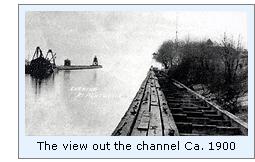 With the dawning of the new century, the Pentwater light station had
been active for almost thirty years, yet action had still to be taken on
the matter of a dwelling for Keeper Evers and his family. Attempting to
rectify the situation, the Lighthouse Board plead the case for a $3,500
appropriation for construction of a dwelling in its 1903 annual report.
After Congress turned a deaf ear to the request, the Board reiterated
the request on an annual basis in its subsequent reports in each of the
following five years. Whether funding was eventually approved has yet to
be identified, however the fact that no mention of the need of such a
dwelling appears after 1908, could indicate that the structure was
indeed built. Keeper Evers resigned his position in 1911, and was
replaced by Andrew J. Davenport who was transferred-in from the Calumet
Pierhead station where he had been serving as keeper since 1888. With the dawning of the new century, the Pentwater light station had
been active for almost thirty years, yet action had still to be taken on
the matter of a dwelling for Keeper Evers and his family. Attempting to
rectify the situation, the Lighthouse Board plead the case for a $3,500
appropriation for construction of a dwelling in its 1903 annual report.
After Congress turned a deaf ear to the request, the Board reiterated
the request on an annual basis in its subsequent reports in each of the
following five years. Whether funding was eventually approved has yet to
be identified, however the fact that no mention of the need of such a
dwelling appears after 1908, could indicate that the structure was
indeed built. Keeper Evers resigned his position in 1911, and was
replaced by Andrew J. Davenport who was transferred-in from the Calumet
Pierhead station where he had been serving as keeper since 1888.
On June 29, 1917, the station was automated through the installation
of an acetylene power system. Equipped with a Sun Valve which
automatically turned the light on with decreasing temperatures at dusk,
and extinguished with increasing temperatures of increasing daylight,
the characteristic was modified to emit a 45-candlepower flash of 0.8
seconds duration followed by an eclipse of 2.2 seconds in order to
reduce acetylene consumption. Congruent with this change, the color of
the beacon was changed from white to red in order to conform to the
"red, right returning" navigation system.
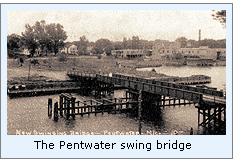 Around 1925 the aging ferry across the channel was replaced by a
swing bridge which was given to village of Pentwater by the Pere
Marquette Railway Company after it was removed from service at Elk
Rapids. Since the bridge needed to be swung open whenever a vessel
needed to enter or leave the harbor, the bridge required a full-time
attendant. Combined with high maintenance costs, the bridge quickly
became the most expensive responsibility of the small villages utility
department. Around 1925 the aging ferry across the channel was replaced by a
swing bridge which was given to village of Pentwater by the Pere
Marquette Railway Company after it was removed from service at Elk
Rapids. Since the bridge needed to be swung open whenever a vessel
needed to enter or leave the harbor, the bridge required a full-time
attendant. Combined with high maintenance costs, the bridge quickly
became the most expensive responsibility of the small villages utility
department.
In 1937, the Army Corps of Engineers completely replaced the timber
piers with more substantial concrete structures, and after 80 years of
service, the venerable timber pierhead beacon was removed from the pier
and replaced by a steel skeleton tower erected on cylindrical concrete
footings. A small shed integrated into the tower housed acetylene tanks
which were piped to a flashing burner mechanism within a 300mm optic
standing at a focal plane of 48 feet. With the establishment of the new
tower, the characteristic of the light was again changed to emit a
single flash of 0.5 seconds duration followed by an eclipse of 4.5
seconds to further conserve acetylene, and reduce the interval between
required service visits.
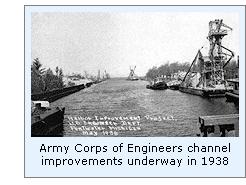 In order to mark both sides of the channel entrance, a cylindrical
modified "D9-type" tower was erected at the end of the north pier in
1997. Topped with a 300mm flashing green Tideland Signal acrylic optic
at a focal plane of 43 feet, the tower also housed a diaphragm fog
signal sounding a single 3-second blast every 30 seconds. In order to mark both sides of the channel entrance, a cylindrical
modified "D9-type" tower was erected at the end of the north pier in
1997. Topped with a 300mm flashing green Tideland Signal acrylic optic
at a focal plane of 43 feet, the tower also housed a diaphragm fog
signal sounding a single 3-second blast every 30 seconds.
The Pentwater of today caters almost exclusively to the summer
vacation trade. The downtown streets have been beautifully restored, and
are now home to craft stores, restaurants and other establishments
designed to tempt visitors to open their wallets. Condominiums line the
lake, and pleasure boats of varying sizes move in and out of the
channel. Virtually all signs of Pentwater’s lumber related past have
disappeared, save a few vestiges of the old Bedstead Factory
foundations.

Keepers of
this Light

Click here
to see a complete listing of all Pentwater
keepers compiled by Phyllis L. Tag of Great Lakes Lighthouse Research.

Finding this Light

From US 31, take Business 31 into Pentwater. Turn west on Lowell
Street at the north end of town and head just under 1/2 mile to Charles
Mears State Park, from where you can walk the beach to the north pier.

Reference Sources

Annual reports of the
Lighthouse Board, various, 1853 – 1909
Annual report of the Lake Carrier’s Association, 1917
Great Lakes Light Lists, various, 1872 - 1999
Pentwater 1853-1942, Florence R. Schrumpf, 1993
Oceana County pioneers and business men of to-day, Hartwick,
Louis M, 1890
Keeper listings for this light appear courtesy of
Great Lakes Lighthouse
Research
|
